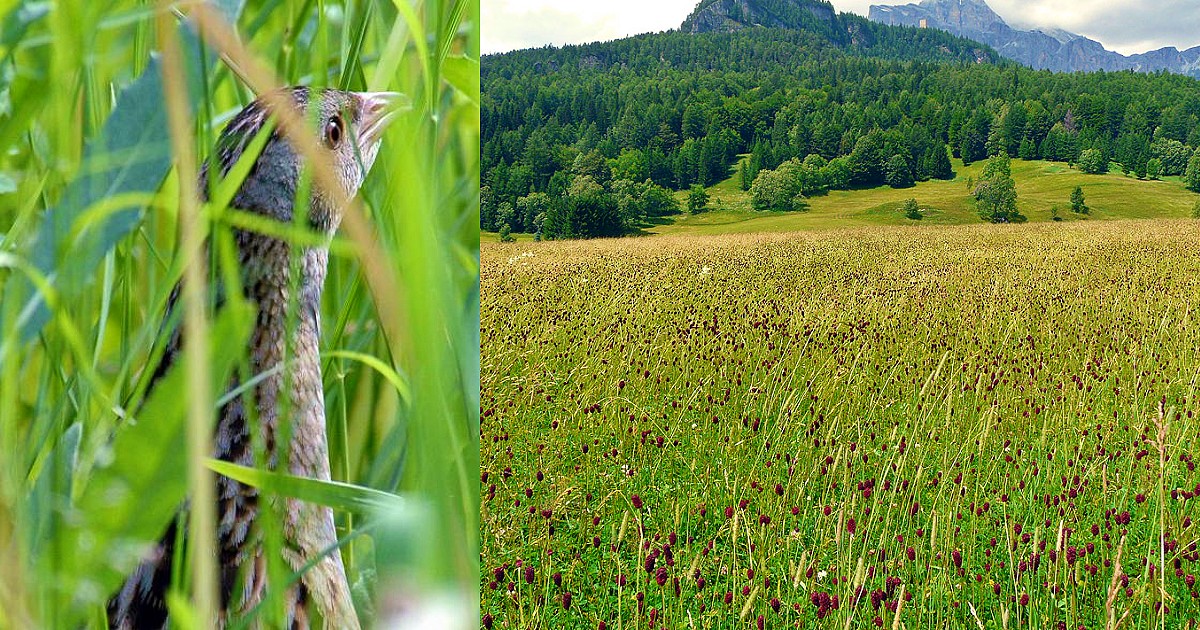Among the ministers, the presidents of the Region, the mayors and the engineers who met at Venezia for the control room of the Winter Olympics Milan-Cortina 2026probably no one knows what the Corncrakescientific name “Crex crex”. It’s about a specie included in Annex II of the European Birds Directivewhich nests in tall grass. It is a bird at risk of extinctionas its survival is linked to “grasslands” which are mowed earlier and earlier than the ripening of the forage. The broods, therefore, are destroyed by the man who devotes himself to agriculture. Its only refuge is in small grassy plots, such as Field below or Piana di Campo, which is located south of the town of cortina d’Ampezzo. It is a meadow which occupies an area of at the edge of the forest 25-30 hectares. But it is precisely there that the Lords of the Olympics have decided to raise, despite the protests of the population, the Village which for a few weeks will host 1,200 peoplebetween athletes and coaches. This way even the little Corncrake will see to disappear the habitat that allows it to to existdue to the placement of prefabricated which will be borrowed and then will be removed after the Olympics. But to equip a site that hosts the equivalent of one fifth of the entire population of Cortina will serve foundationinfrastructure for sewerselectric energy, gasdisposal of waste. And the environment will be hopelessly transformed.
“We will assemble and dismantle the village, it will be an occupation temporaryno expropriation, indeed we will indemnify the owners”, said the extraordinary commissioner of the government, the engineer Luigi Valerio Sant’Andreaduring a meeting with the press a Palazzo Balbi, headquarters of the Veneto regional council. “Everything will return to its current state,” added the Northern League governor Luca Zaia. In a word, for the organizers the village shouldn’t create no damage to the environment. It will be an expense lost fundwhich provided for an allocation of 47 million 827 thousand eurosof which 10 million to be paid by the State and the remaining 37 million 827 thousand euros to be paid by Veneto region. In the Olympic bid, the location was expected to be north of Cortina, in the area of Fiames. But then they realized that it is one landslide area and geologically unstable, even if with a delayed explosion compared to what environmentalists and connoisseurs of the local reality had denounced. A few months ago, after setting aside other hypotheses (the former powder magazine structures of Cimabanche the case from Eni in Borca di Cadore), here comes the Campo di Sotto hypothesis.
The inhabitants have already descended on the warpath. They met in two crowded assemblies and decided the resistence to the bitter end, giving mandate to a link to resort to Tar against the provisions that Società Infrastrutture Milano Cortina will adopt to obtain the availability of the area. Meanwhile the Cortina Civic Committeewhich two years ago collected thousands of signatures against the creation of the new bobsleigh track, released a worrying report. To write it is Michael DaPozzo, forest doctor and director of the Dolomiti d’Ampezzo Natural Park managed by the Rules. Da Pozzo is an environmental scholar and reconstructs the meaning of Campo di Sotto from a naturalistic point of view, whose “uniqueness and fragility” are questioned by the Olympic Village.
“These fragilities – he writes – are due to the inherent sensitivity of the natural habitat, in particular due to the presence of endangered species (on a regional basis), sensitive to any type of tampering, and in relation to hydrogeological dynamics, which underlie the uniqueness of the habitat mosaic. Any intervention of an infrastructural nature, therefore, would alter irreversibly the delicate balances, justifying, on the contrary, the historic and only destination ad agricultural activity”. La Piana has a post-glacial origin on the site of an ancient barrier lake. “Over time, a continuous clod of grass has been created, mostly cultivated with forage and occasionally grazed in autumn, since the first stable agricultural settlements in the Ampezzo valley. – writes Da Pozzo – The centuries-old agricultural practice of landowners, low-impact conduct, with fertilizations regularbut never abundant and liquid, and with one or two annual mowings, has led to the formation of an extremely rich in biodiversity”. It’s about a unique situation in the Dolomites area. “The Piana di Campo has been kept in an excellent and almost incredible state of near-natural conservation”. The European classification system of Nature 2000 it brings the habitat back to a mosaic of two environmental types, the “grasslands with molinia on calcareous, peaty or clayey-silty soils” and the “lean hay meadows with sanguisorba officinalis”. And it is there, in addition to plant species, that the extremely rare are found Corncrakeil goldfinch and thehave it small.
Until now Piana di Campo had been preserved from human exploitation, apart from a few camping with curtains. “If a habitat like this were manipulated for even temporary residential purposes – writes Michele Da Pozzo – it would require earthworks, whether excavation or landfill, which would irreversibly alter the type of turf settled there over the centuries and constantly maintained by man”. Fixing what will be altered would only lead to cover with grass the campaign plan, but “would not restore the habitatwith the biodiversity related to them, which it would take centuries to replace the fictitious cover obtained with artificial grassing and, with the current rainfall regimes, at the cost of consistent and constant irrigation”. The floodplain would come compromised and “the post-glacial colonization process would be restarted from scratch, lasted millennia and certainly not definable as a serious ‘environmental restoration’”. What nature has created over hundreds of centuries would be altered to create a human settlement of few weekswith irreversible damage to “an extraordinary landscape prominence in the context of the Ampezzo basin, due to its remarkable integrity e visibilityespecially from the access road to the town from the south”.
